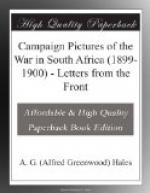these men, and followed along the same road they had
taken. The ravine was a long, narrow gap between
mountain ranges of immense height. The sides of
the mountains were covered with loose boulders, sufficient
to protect the whole Boer army from our artillery
fire. The only track which a horseman could possibly
follow wound in and out alongside the face of the
cliffs, so narrow that even the horses bred in the
country found it difficult to keep their feet upon
it, and could only proceed, at funeral pace, in single
file. A handful of men could have held that place
against an army. With De Wet and Olivier gone,
half our task was over. The Boers made a blind
rush, first to one nek, then to the next, only to
find that Britain’s sons guarded them all.
Small bodies of men might escape, but the vast supplies
of mealies, waggons, guns, and all the cumbrous appliances
of war, without which an army is useless, were penned
in. The hand of the Field-Marshal was on them.
The blocking forces held the neks, and now those forces
which had to strike were ordered to move. No
sooner did General Rundle receive his orders to advance
than he rolled forward with the impetuosity of a storm
breaking upon a southern coast. They on the spot
knew that all the enemy’s hopes lay centred round
a town in the middle of the valley. This town
was Fouriesburg. The general who could strike
that town first would deal the death blow to the Boer
forces in the Free State. Rundle was furthest
from the town; the pathway his troops would have to
pursue was rougher and more rugged than that which
lay open to the rest of the forces.
But Rundle knew his men; he knew their mettle; he
had tried them with long, weary marching, and he knew
that they were worthy of his trust. He gave his
orders. The Leinsters and the Scots Guards, tall,
gaunt, hunger-stricken warriors, whose ribs could
be counted through their ragged khaki coats, swung
out as cheerily as if they had never known the absence
of a meal or the fatigue of a dreary march. The
Irishmen chaffed the Scots, and the Scots yelled badinage
back to the sons of Erin, and onward they went, onward
and upward, over the rock-strewn ground, through the
narrow passes, fixing their bayonets where the ground
looked likely to hold a hidden foe, ready at a moment’s
notice to charge into the blackness that lay engulfed
in those dreary passes. But the enemy did not
wait for them. As the Eighth Division advanced,
making the rocky headlands ring with the rhythm of
their martial tread, the Boers fell back like driven
deer, and the bugle spoke to the Scottish bagpipe
until the silent hills gave tongue, and echo answered
echo until the wearied ear sickened for silence.
Onward we swept, until Commando Nek lay like a grinning
gash in the face of nature far in our rear. When
we did halt the men threw themselves down on the freezing
earth, and wolfed a biscuit; then, stretching themselves
face downwards on the grass, they slept with their




